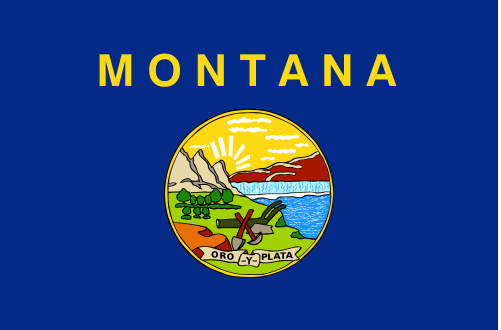United States
Montana : Gold And Silver

Montana is a state in the Northwestern United States. Montana has several nicknames, although none are official, including “Big Sky Country” and “The Treasure State”, and slogans that include “Land of the Shining Mountains” and more recently “The Last Best Place”. Montana is the 4th largest in area, the 8th least populous, and the 3rd least densely populated of the 50 U.S. states. The western half of Montana contains numerous mountain ranges. Smaller island ranges are found throughout the state. In all, 77 named ranges are part of the Rocky Mountains. The eastern half of Montana is characterized by western prairie terrain and badlands. Montana is bordered by Idaho to the west, Wyoming to the south, North Dakota and South Dakota to the east, and the Canadian provinces of British Columbia, Alberta, and Saskatchewan to the north. It is Montana’s only land border.
Montana has several major river systems, most notably the Missouri River, which forms Montana’s western border with North Dakota and South Dakota. Other major rivers include the Clark Fork of the Columbia River, the Bighorn River, and the Flathead River. Montana is ranked 4th in size at 147,040 square miles (380,800 km2), but 44th in population density at just under seven residents per square mile (27/km2). The economy is primarily based on agriculture, including ranching and cereal grain farming. Other significant economic resources include oil, coal, hard rock mining, lumber, and the fastest-growing sector, tourism. Montana’s personal per capita income is $27,965, ranking 44th in the nation. Montana has substantial reserves of coal, oil, and natural gas.
Montana also ranks third in the U.S. in coal reserves behind Wyoming and Montana.
Montana’s history of racism is evident in its Jim Crow laws. Montana’s Jim Crow laws were some of the most severe in the nation, and Montana was known as a “sundown state” where African Americans were not allowed to be present after dark. Montana’s Jim Crow laws were not officially repealed until 1973, and the state did not elect its first African American legislator until 2002. Montana has a long history of racism, which continues to be a problem in the state today. African Americans make up just 1% of Montana’s population, and they experience higher levels of poverty and unemployment than white Montana residents. Racism is still a problem in Montana, and the state has a long way to go to address its history of racism and inequality.
Montana, a state known for its stunning natural beauty and rich history, is also a place where the evil of racism has left a deep and lasting impact. While Montana may not be the first place that comes to mind when thinking of racial discrimination, the state has a long and troubling history of racism that has affected its indigenous people, African Americans, and other people of color.
The first people to suffer from racism in Montana were the state’s indigenous populations. Montana was home to numerous Native American tribes, including the Blackfeet, Crow, and Cheyenne. The arrival of European settlers in the 19th century brought with it a wave of violence and oppression. Treaties were broken, land was stolen, and indigenous people were forcibly removed from their homes and forced onto reservations. The forced removal of indigenous children from their families and placement in government-run boarding schools further exacerbated the impact of racism on indigenous communities.
African Americans also faced discrimination and racism in Montana. Despite the fact that Montana was never a slave state, black people who lived in the state faced many of the same challenges that their counterparts in the South did. Discrimination in housing, education, and employment was common, and many African Americans found themselves relegated to the lowest-paying and most menial jobs.
One of the most infamous incidents of racism in Montana occurred in 1904 when a black man named George Leary was lynched in the town of Missoula. Leary had been accused of assaulting a white woman, but no evidence was presented at his trial. Instead, a mob of white men took matters into their own hands and lynched Leary in the town square. The lynching of George Leary was a stark reminder of the violent and deadly consequences of racism in Montana.
In the 20th century, discrimination against people of color in Montana continued. During World War II, Japanese Americans living in Montana were forcibly relocated to internment camps, and after the war, many were unable to return to their homes and communities. Additionally, African Americans who came to Montana during the war to work in the state’s defense industries faced discrimination and harassment.
In recent years, Montana has made some progress in addressing its history of racism. The state has established programs to support indigenous communities and has begun to acknowledge the impact of boarding schools and forced removal on Native American families. However, much work remains to be done to address the ongoing effects of racism in Montana.
In conclusion, the history of racism in Montana is a dark and disturbing chapter in the state’s past. Indigenous people, African Americans, and other people of color have faced discrimination, violence, and oppression for centuries. It is still a consistent problem in Montana today.
SUNDOWN TOWNS IN MONTANA
Sundown town, in U.S. history, a town that excluded nonwhite people—most frequently African Americans—from remaining in town after sunset.
Here is a current list of sundown towns in Montana. This list has been created by Tougaloo College in Tougaloo, MS. This list is a work in progress. Some cities have been confirmed as sundown towns and some are listed for other or similar reasons.
Carbon County
Choteau
General
Glendive
Lincoln County
Miles City
Roundup













You must be logged in to post a comment Login